Touchscreens in the Automotive Environment
Touchscreens offer many features and benefits despite a hostile operating environment
By Bruce Devisser
Fujitsu Components America
Sunnyvale, CA
Touchscreens are the interface of choice in vehicular telematics, appearing in applications from electronics entertainment to GPS navigation and environmental control. The automotive environment is a hostile place for electronic components to function properly, with the main adversaries being temperature, humidity, vibration, and shock. Telematics applications are subjected to all of these and more.
Most automotive applications require several buttons to select features and functions. With a touchscreen, the modality of these buttons can be changed on the fly to different positions, shapes, and sizes to suit the user at the moment interaction is required.
Touchscreen Types
Existing touch interfaces are primarily resistive-type touch panels (RTPs), which can meet the challenges of environment and user mainly because of the materials used in their construction: glass on glass and film on glass (see table). Currently, the most popular is glass on glass, which is composed of a glass substrate with a very thin glass top layer (see Fig. 1).

Glass-on-glass (GG) touch panels can withstand high-temperature operating environments over long periods of time--a major requirement of automotive markets. This ability comes with a high price and two significant compromises: low positional resolution and a somewhat fragile operating surface. These drawbacks are both characteristics of the thin (approx. 0.1 to 0.2-mm) glass top layer, where the stiffness restricts flexibility and the minimal thickness does not tolerate impact energy as well as would be desired.
Film on glass (FG) is the most prevalent construction found in RTP technology, and is generally viewed as the low-cost solution for touch technology. Until very recently, FG construction was not suitable for automotive applications because of unstable performance at temperatures above 60°C.
The flexible film top layer, typically a carrier of polyethylene terephthalate (PET) bonded to an indium tin oxide-coated thin film on a glass substrate, can stretch, debond, and deform when operated at high temperatures, causing permanent failure of the touch panel. In addition, extremely high humidity can cause condensation inside an FG touch panel. In contrast, GG panels are immune to this condensate contamination because of their nonporous, top glass layer (see Fig. 2).

Recent Developments
Recent materials research by companies such as Fujitsu has produced commercially available, flexible plastic carriers that can operate reliably at temperatures up to 85°C while maintaining the beneficial operating characteristics of PET films. This development, complemented by parallel advances in film and coating technologies, has caused design engineers to view FG touch panels in a new light.
Although automotive-grade FG touch panels are more costly than lower-temperature versions, they are still significantly less expensive than GG types, and at the same time offer improved features and performance. For example, higher resolution means design flexibility (such as placement of soft buttons for item selection) and easy, fine adjustment of button position to minimize single-point wear and therefore maximize product life without increasing cost.

Environmental Requirements
Environmental considerations such as vibration and shock are important for both GG and FG types insofar as their glass substrates are concerned. Typically, the touch panel is affixed to the LCD with some type of nonhardening interface material, and the assembly is shock mounted to the equipment enclosure. Appropriate treatment of the interface surface area between the touch panel's top surface and enclosure is a primary concern for designers to prevent road shock and vibration transmission that could damage the touch panel or LCD.
The current trend among major automotive design houses to bring the outdoors inside the vehicle through increased glass area is creating new awareness of sunlight-readability value to the consumer. When a touch panel is added to the LCD, the optical stackup can produce some undesirable effects. These typically include reduced transmission of LCD light, ambient- and spot-lighting reflections, and distracting patterns produced by optical interference.
The most effective touch-panel treatment for a sunlight-readable application is a combination of antireflection and polarizing filters in the touch panel. When used with a high-performance transmissive LCD, a high-contrast image is presented with low-reflected-light interference, ensuring readability even in direct sunlight. These types of enhancements are configurable according to performance and technical requirements, such as viewing and polarization angles.

